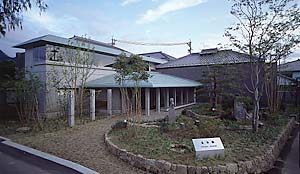
[ Introduction | Displayed Works | Transportation Routes to the Museum ]
Introduction
Katsushika Hokusai's depiction of ukiyo-e, the floating world, has a humble beginning as a plebeian skill during the Edo era (1603 - 1867). Over time, his works have achieved international acclaim, crossing boundaries of nationalities and periodic styles. It was here in Obuse, a town in Nagano Prefecture, that this man who is now known as a cultural giant produced masterpieces of his final years.
During his lifetime which began in 1760 in Honjo, Edo and ended in 1849 in Asakusa, Edo, Hokusai produced countless works of invaluable art. His exceptional talent first came to light in his late 30's with a series of bijin-ga (pictures of beautiful women) under pseudonyms of Sori and Hokusai Tokimasa.
In his 40's and 50's, Hokusai's sensational innovations were reflected in his illustrations for yomihon and pictures for edehon books. His masterpiece FUGAKU SANJUROKKEI Thirty-Six Views of Mt. Fuji is a work from his 70's which gave way to a new genre of landscape prints for the art of ukiyo-e.
In his later years, Hokusai began to ignore the support of publishing critics and focused his individuality through brush painting. And with the help of his friend Takai Kozan, a tycoon in Obuse, Hokusai successfully completed his most celebrated works, massive ceiling pieces.
Hokusai Museum was established in 1976 to maintain the condition of valuable brush paintings and ceiling works attached to two festival floats. The museum building which underwent expansion and renovation in 1991 now displays Hokusai's works featuring brush paintings and book illustrations.
Displayed Works
Festival Floats -- Two festival floats (designated official treasure of Nagano Prefecture) with Hokusai's paintings attached to their ceiling are stored and displayed in this room. At 85, Hokusai prepared the RYU (Dragon) and HO-O (Phoenix) paintings on the Higashi-machi Festival float over a six-month period. The DOTO Angry Waves painting consists of the Masculine Waves and the Feminine Waves which are attached to the Kan-machi Festival float.
The Kan-machi Festival float also features Hokusai-designed carvings based on the Chinese legend SUIKODEN.
Brush Paintings -- Hokusai's hanging scrolls, folding screens, picture albums, sketches and letters are displayed in a room of authentic Japanese decor.
Hokusai's brush paintings that were produced in Obuse or brought to the town by Kozan were later taken out of the country. The works traveled through Europe; but KIKUZU Chrysanthemums and NAMAKUBI A Head Cut off eventually made their way back to Japan and to this museum in Obuse.
Other displayed works representing Hokusai's youth, peak, and final years include RYUKA KASAMOCHI BIJIN Beauty with an Umbrella beneath a Willow Tree, NANAKOMACHI Seven Figures of Ono-no-Komachi, SHIRABYOSHI Heian Court Performer.
Published Books -- Hokusai was a revolutionary illustrator of the printing industry of his time as well. In the published book genre alone, his illustrations for the kyoka ehon, yomihon, edehon and ehon publications boast works that will remain in history.
The Hokusai Museum features the artist's published books from the Sunohara collection.
Films -- An 18-minute film Gakyo: Hokusai and His Brush Paintings and a 14-minute film Obuse and Hokusai are played alternately through a slide projector in a cozy theater with a seating capacity of sixty. The 7-meter wide screen captures the dynamic images of the art.
Admission: 500 yen for adults, 300 yen for elementary, junior high, and senior high students (10% discount for a party of 20 or over).
Museum Hours: 9 a.m. - 5 p.m. for the months of April through October, 9:30 a.m. - 4:30 p.m. for the months of November through March, closed on December 31 and January 1.
485 Obuse, Obuse-machi, Nagano-ken / 026-247-5206
Transportation Routes to the Museum (Route Map)
By Train
Tokyo (Hokuriku Shinkansen "Asama") - Nagano: 1 hr. 19 min.
Nagano (Nagano Dentetsu) - Obuse: 20 min. on the express, 30 min. on the local.
10-min. walk from Obuse Station.
By Car
10 min. from the Asano Minami crossing on Route 18, 20 min. from the Suzaka Nagano Higashi Interchange and 10 min. from the Nakano Interchange on the Joshin-etsu Jidoshado.
